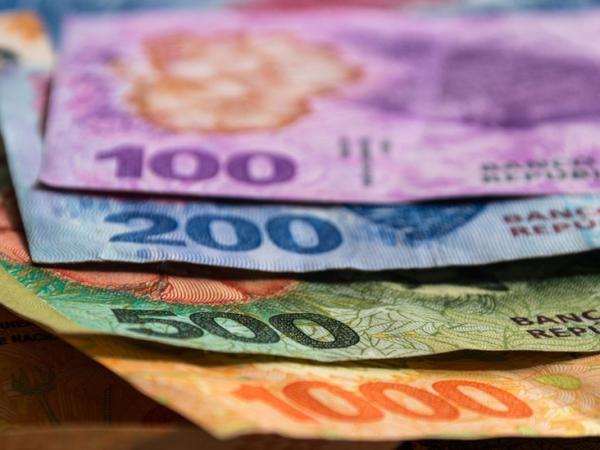The last time the US Federal Reserve raised interest rates as aggressively as we are seeing these months, the IMF had to bail out Mexico.
The rest of the Latin American economies did not fare much better.
Because when the US Central Bank tightens, the region suffocates.
Experts predict that now it will not be different either and each economy will feel differently the sharp rise in interest rates by the Federal Reserve, which in just 3 months increased the reference rate to a range between 1.5% and 1.75%.
The goal is to fight runaway inflation, the highest in more than 40 years, but the danger is that by trying to contain rising prices, the US economy will enter a recession dragging the rest of the world down with it.
Admittedly, it’s not all bad news.
Kirstie Spence, fixed income manager at Capital Group, recalls that “some countries in Latin America have been somewhat protected against rising food prices, as they produce locally and are less dependent on wheat and cereals.”
In addition, there are countries that have been preparing for this scenario for some time.
But which one is better placed? Who will be able to face the economic environment that is coming without its citizens feeling the blow?
“The economies that are best prepared to face the Fed’s increases are those with moderate levels of debt and fiscal deficit, flexible exchange rates and modest external financing requirements,” Caludia Calich, fixed-income manager, explains to BBC Mundo. emerging from M&G Investments.
Within Latin America, that would include countries like Peru, Guatemala, and Paraguay.
On the contrary, for the analyst, the worst prepared would be El Salvador and Bolivia.
And what about the rest?
We review who will be able to face the situation that is coming more calmly and which of the main economies could be in trouble.
What happens when the Fed raises interest rates is that investors withdraw their capital from risky markets and put it into safer investments, such as US debt.
The tightening of global financial conditions roughly means that investors are more or more likely to earn elsewhere and take elsewhere the oil that keeps the gears of an economy running at full throttle: money.
“A reversal of capital flows exposes imbalances,” says David Rees, senior emerging markets economist at Schroders.
“Capital outflows make deficits no longer financeable, which, combined with higher interest rates, leads to recession.”
“In the 1994 Mexican peso crisis, external vulnerabilities were exposed when the Fed hiked rates aggressively and at a time of political change,” Rees recalls.
But we are no longer in the 1990s and Latin America’s second largest economy, analysts agree, has been doing things right.
At the moment the country enjoys a balanced fiscal situation.
“Mexico’s economy is much better than during the tequila crisis – as the 1994 crisis was called -. This time, external shock absorbers are strong. Foreign currency debt is low and the Mexican peso floats freely,” explains Edward Glossop. , an economist from Abrdn.
“As such, the economy should certainly be able to get by without a crisis,” he adds.
And it is that unlike other Latin American countries, the Mexican government decided not to stimulate the economy during the pandemic and that is why the fiscal situation “has not deteriorated much.”
In fact, says Patricia Urbano, a fund manager at Edmond de Rothschild AM, their position is strong.
That means that the Central Bank of Mexico has some room for maneuver to implement some measures.
In addition, “Mexican exports are gaining market share compared to what the United States imports and inflation is moderate.”
“If we look at the long term, the Mexican economy is expected to benefit from the offshoring trend, in which the United States is diversifying its supply chain and decreasing its dependence on China,” says Urbano.
Mining has made Chile the world’s largest copper exporter, but the coronavirus pandemic has slowed production.
In a context of rising rates from the United States, Chile tends to outperform other Latin American countries in relative terms.
This is because “the Chilean economy is more closely related to China and to the electric vehicle supply chain, due to its role not only as a major exporter of copper but also as the cheapest,” says Urbano.
If the United States slows down, Chile will suffer, but its ties to China may act as a buffer.
In addition, the Edmond de Rothschild AM expert recalls that the Chilean government has little debt.
But Chile has also accumulated external imbalances and since it needs to buy its energy abroad “this could cause a further deterioration of the current account deficit”, believes Schroders economist David Rees.
“In Latin America, the worst prepared economy is Colombia, which has a high twin deficit,” says Urbano.
The twin deficits refer to a macroeconomic imbalance, where an excess of spending must be financed with another deficit: that of the current account of the balance of payments. Foreigners finance the largest expenditure.
“Despite the fact that Colombia is an oil producer and higher oil prices for longer could support its economy, the country has large imbalances,” adds the economist.
“Colombia needs structural reforms to reduce its fiscal and trade deficits. The need for external financing is key,” he says.
Combining the solution of the fiscal deficit with the fulfillment of the promises of social changes will be an important challenge for the new government of Gustavo Petro.
“Petro’s victory will fuel short-term uncertainty among investors, as markets fear it could disrupt Colombia’s historic regulatory stability and business-friendly environment,” says Jimena Blanco, head of the Latin America division of the signs Verisk Maplecroft.
For the analyst, those doubts will be stronger within the extractive sector, since Petro has promised to move the country’s economy away from these crucial industries right now for its economy.
And it is that the evolution of the price of raw materials will be key to determining how much it affects Colombia that the growth of the United States slows down.
“A key thing to consider will be the extent to which the US slowdown is going to drag down commodity prices. That would weaken trade with the region and lead to further slowdowns,” Rees explains.
According to the UN, there are 5 countries in the region with severe financial vulnerabilities: Argentina, Venezuela, Ecuador, Belize and Granada.
“On the list of the worst prepared, there are obvious candidates like Venezuela, where the economy has been rock bottom for years,” says Blanco.
In the case of Argentina, the country “struggles with one of the highest levels of inflation in the world and received one of the biggest economic blows during the pandemic.”
The policy and the measures that can be adopted will be key for the country, but “the ruling coalition cannot set a straight course in terms of macroeconomic policy,” he says.
And with the country heading into another election year in 2023, “any hope of a coordinated and sustainable economic policy is short-lived,” the analyst explains.
Remember that you can receive notifications from BBC Mundo. Download the new version of our app and activate it so you don’t miss out on our best content.
BBC WORLD
















